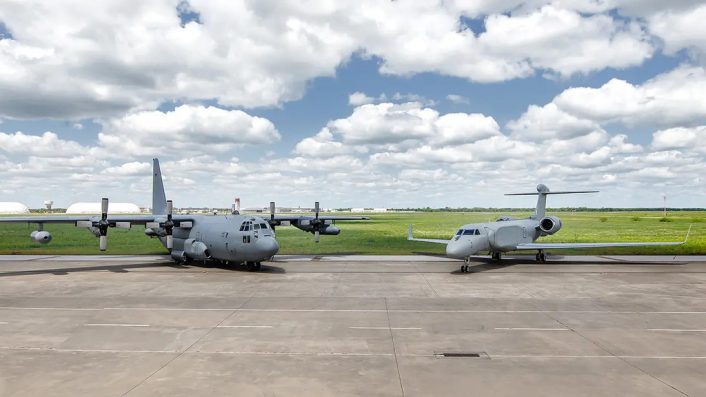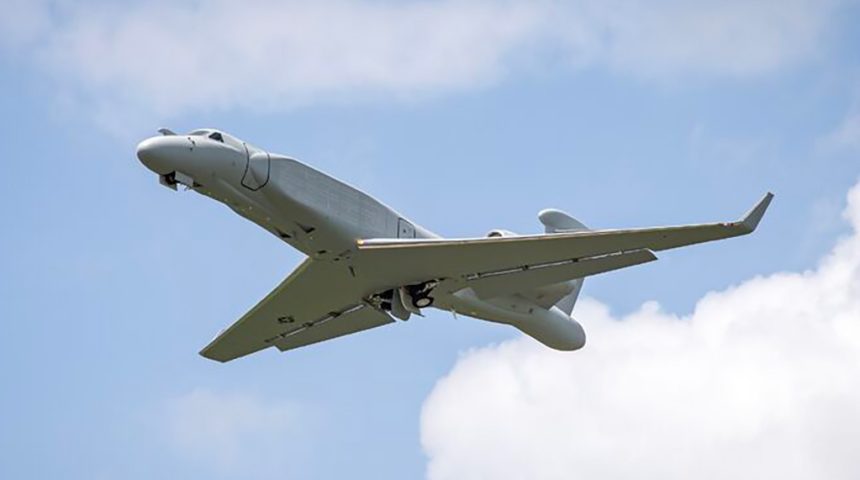The EA-37B aircraft designation was selected to better identify the platform’s mission of finding, attacking and destroying enemy land or sea targets.
The U.S. Air Force Air Combat Command disclosed last week that, effective Oct.27, 2023, the EC-37B has been redesignated to become the EA-37B to better identify the platform’s mission of finding, attacking and destroying enemy land or sea targets. Additionally, the EA-37B will assume the name “Compass Call” in fiscal year 2026 or upon retirement of the EC-130H, should that happen earlier.
In the press release, the ACC disclosed that 9 of 14 EC-130Hs have already been divested and stored at the 309th Aerospace Maintenance and Regeneration Group located at Davis-Monthan AFB. Air and Space Forces Magazine reports that the aircraft are being stored in flyable storage, meaning that are being preserved to possibly be returned to duty if needed.
One EA-37B has been delivered to Air Force Materiel Command for development and operational testing. The aircraft performed its first test flight in the fully missionized configuration and USAF livery on May 4, 2023, from L3Harris’ integration and modification center in Waco, Texas. The delivery of the first EA-37B to the 55th Electronic Combat Group at Davis-Monthan Air Force Base, Arizona, is expected in 2024.
The U.S. Air Force is projecting its electronic attack capabilities into the future, upgrading and transitioning the Compass Call airborne tactical electronic attack weapon system from the 40 years old EC-130H to the new EC-37B. The Compass Call system is one of the busiest assets of the entire US inventory, which took part in every conflict where US troops were engaged in combat.
Compass Call disrupts enemy command and control communications, radars, and navigation systems and limits adversary coordination, as part of the Counter-Command, Control, Computers, Communications, Cyber, Intelligence, Surveillance and Reconnaissance Targeting (Counter-C5ISRT) mission. Restricting an adversary’s battlespace coordination and force management, as well as suppressing the air defenses, is essential in today’s operational scenarios to improve the chances of missions’ success.

In the press release, the Air Force says the EA-37B sustains Joint Force military advantage in electromagnetic battlespace and builds a more lethal force by modernizing electromagnetic attack capabilities to deny peer competitors’ tactical networks and information ecosystems. The Department of Defense is, in fact, taking steps to keep the edge over adversaries and to counter advanced and non-traditional threats.
A new factsheet has also been released by the service; here is an excerpt:
The EA-37B aircraft carries a combat crew of up to nine people. The pilot and co-pilot are responsible for aircraft flight, while an additional seven members operate and employ the EA mission equipment permanently integrated into the cargo/ mission compartment. The mission crew can include the mission crew commander (electronic warfare officer), weapon system officer (electronic warfare officer), mission crew supervisor (an experienced cryptologic linguist), analysis operators (linguists), one acquisition operator and/or an airborne maintenance technician.
Compass Call is designed with System-Wide Open Reconfigurable Dynamic Architecture (SWORD-A) capabilities, which allow for rapid updates to adopt new capabilities and counter emerging technologies, tactics, techniques and procedures.
Its adaptability is directly attributed to its spiral upgrade acquisition strategy which ensures the EA-37B can counter new, emergent communication technology.
The aircraft effectively jams communications, Early Warning/Acquisition radars and navigation systems during tactical air and ground operations.
A majority of the components found in the EA-37B Compass Call are classified modifications to the mission system that enhance precision and increase target capacity. The system was designed to incorporate options for “plug-and-play” quick reaction capabilities, which have historically allowed the program to counter unique high-profile threats. This flexibility allows the aircraft to keep pace with adversary use of emerging technology. It promotes enhanced crew proficiency and effectiveness, maintenance and sustainment with a common fleet configuration, new operator interfaces, increased reliability and better fault detection.
The aircraft’s communication capabilities have been improved with an expansion of satellite communication connectivity compatible with emerging DoD architectures, increased multi-asset coordination nets and upgraded data-link terminals.
Improved external communications allow Compass Call crews to maintain situational awareness and connectivity in dynamic operational and tactical environments. Furthermore, modifications to the airframe provide improved aircraft performance and survivability.
In the U.S. Department of Defense there is only another aircraft with the EA designation, the EA-18G Growler, in service with the Navy and with the Air Force’s 390th Electronic Combat Squadron. Together with the EA-18G Growler and the F-16CM Block 50/52 Fighting Falcon, Compass Call is part of the US Suppression of Enemy Air Defense (SEAD) triad.
The EA-18G is equipped with an Airborne Electronic Attack (AEA) avionics suite that can detect, identify, locate and suppress hostile electromagnetic emitters. In the future, with the Block II Growler upgrade and the NGJ (Next Generation Jamming) pods that will provide enhanced AEA capabilities, the Growlers will also get Cyber Attack capabilities.
You can find out more about the EC-37B Compass Call in the detailed report we published here at The Aviationist earlier this year.









